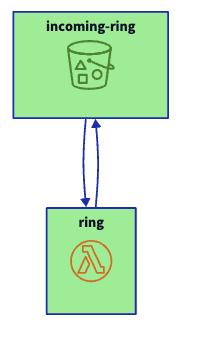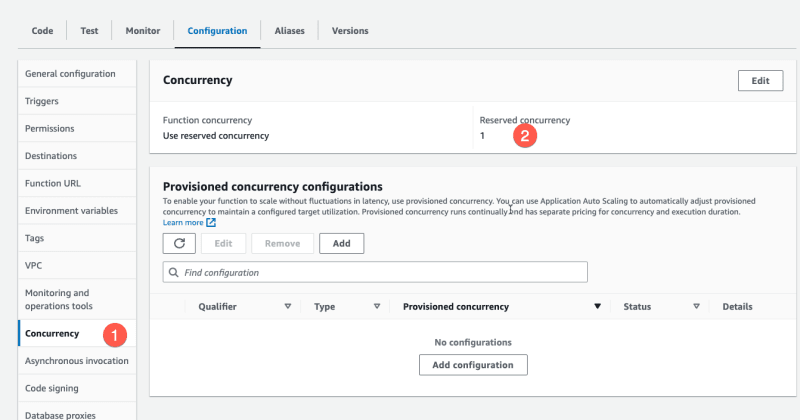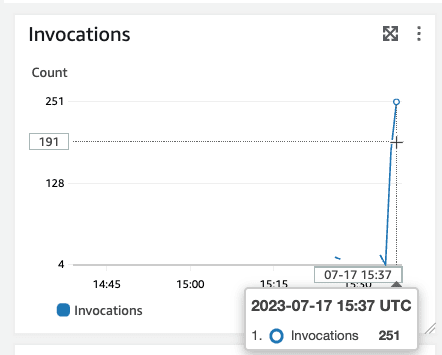AWS Lambda recursive loop detection - but not (yet) for S3

Gernot Glawe
Posted on July 17, 2023

Recursive loops in AWS Lambda are the root of all evil because you create a large bill quickly.
You might think the danger is over because of new AWS recursive loop detection. But what about S3 buckets and Lambda? It's time for a closer look:
A word of caution: Be very careful when you test this. You could create large AWS bills.
TL;DR: Never ever use the same bucket for invoking a Lambda and write the output.
Some testing infrastructure:
1) A S3 bucket (CDK, GO)
bucky := awss3.NewBucket(stack, aws.String("incoming-ring"), &awss3.BucketProps{
BlockPublicAccess: awss3.BlockPublicAccess_BLOCK_ALL(),
RemovalPolicy: awscdk.RemovalPolicy_DESTROY,
})
2) A Lambda Function Resource
ringFunction := awslambda.NewFunction(stack, aws.String("ring"),
&awslambda.FunctionProps{
Description: aws.String("ring - test recursive loop stop"),
FunctionName: aws.String("ring"),
LogRetention: awslogs.RetentionDays_THREE_MONTHS,
MemorySize: aws.Float64(1024),
Timeout: awscdk.Duration_Seconds(aws.Float64(10)),
Code: awslambda.Code_FromAsset(&lambdaPath, &awss3assets.AssetOptions{}),
Handler: aws.String("main"),
Runtime: awslambda.Runtime_GO_1_X(),
DeadLetterQueueEnabled: aws.Bool(true),
DeadLetterQueue: dlq,
})
3) A Lambda Function, which gets the PutObject Event and write to the same bucket:
someString := "hello world\nand hello go and more"
myReader := strings.NewReader(someString)
resp, err := client.PutObject(context.TODO(), &s3.PutObjectInput{
Bucket: aws.String(bucket),
Key: aws.String(s3input),
Body: myReader,
})
4) An event, which triggers the Lambda function each time an object is Put to the bucket:
myHandler.AddEventSource(event.NewS3EventSource(bucky, &event.S3EventSourceProps{
Events: &[]awss3.EventType{awss3.EventType_OBJECT_CREATED,},
}))
Now we have:
And because I am very careful, I decide to create a recursive loop stopper inside the Lambda function:
GlobalCounter++
if GlobalCounter > 20 {
log.Fatal("Counter exceeded\n")
os.Exit(1)
}
And in the Console, we set the concurrency to 1:
When we test the recursive loop, we always have a browser window with the concurrency open. Because: Setting the concurrency to 0 is the fastest way to stop an endless loop.
The test
Lets test whether S3-Lambda-S3 recursive loops are still possible:
We use saw to tail lambda log:
saw watch /aws/lambda/ring
And then start the recursive loop:
aws s3 cp README.md s3://ring-incomingring3eb9a9b9-1a8q8cp8qm2ch/readme1.md
upload: ./README.md to s3://ring-incomingring3eb9a9b9-1a8q8cp8qm2ch/readme1.md
Very fast you get the logs:
[2023-07-17T17:34:39+02:00] (2023/07/17/[$LATEST]e27ec4706f1a4fb0a6d3ca1fdb23bbc0) INIT_START Runtime Version: go:1.v18 Runtime Version ARN: arn:aws:lambda:eu-central-1::runtime:ccb68acb59818f9df9b10924cc6c83ca6eaf4067f70ba861c0e211b59e8af729
[2023-07-17T17:34:39+02:00] (2023/07/17/[$LATEST]e27ec4706f1a4fb0a6d3ca1fdb23bbc0) START RequestId: 10fba020-0e93-4430-a9d7-728d34b146c9 Version: $LATEST
[2023-07-17T17:34:39+02:00] (2023/07/17/[$LATEST]e27ec4706f1a4fb0a6d3ca1fdb23bbc0) Counter: 1
[2023-07-17T17:34:39+02:00] (2023/07/17/[$LATEST]e27ec4706f1a4fb0a6d3ca1fdb23bbc0) Etag: 446cce24a7c945503232494e881150ec
[2023-07-17T17:34:39+02:00] (2023/07/17/[$LATEST]e27ec4706f1a4fb0a6d3ca1fdb23bbc0) Seq: 0064B55F8E25E34383
[2023-07-17T17:34:39+02:00] (2023/07/17/[$LATEST]e27ec4706f1a4fb0a6d3ca1fdb23bbc0) END RequestId: 10fba020-0e93-4430-a9d7-728d34b146c9
[2023-07-17T17:34:39+02:00] (2023/07/17/[$LATEST]e27ec4706f1a4fb0a6d3ca1fdb23bbc0) REPORT RequestId: 10fba020-0e93-4430-a9d7-728d34b146c9 Duration: 92.67 ms Billed Duration: 93 ms Memory Size: 1024 MB Max Memory Used: 39 MB Init Duration: 110.22 ms
[2023-07-17T17:34:40+02:00] (2023/07/17/[$LATEST]e27ec4706f1a4fb0a6d3ca1fdb23bbc0) START RequestId: 97cf261e-b272-437f-9637-b7573cfb0fa8 Version: $LATEST
[2023-07-17T17:34:40+02:00] (2023/07/17/[$LATEST]e27ec4706f1a4fb0a6d3ca1fdb23bbc0) Counter: 2
[2023-07-17T17:34:40+02:00] (2023/07/17/[$LATEST]e27ec4706f1a4fb0a6d3ca1fdb23bbc0) Etag: a9c4c5f405a3e4cc6ba3b6b355da0e71
[2023-07-17T17:34:40+02:00] (2023/07/17/[$LATEST]e27ec4706f1a4fb0a6d3ca1fdb23bbc0) Seq: 0064B55F8FD24FBE14
[2023-07-17T17:34:41+02:00] (2023/07/17/[$LATEST]e27ec4706f1a4fb0a6d3ca1fdb23bbc0) END RequestId: 97cf261e-b272-437f-9637-b7573cfb0fa8
[2023-07-17T17:34:41+02:00] (2023/07/17/[$LATEST]e27ec4706f1a4fb0a6d3ca1fdb23bbc0) REPORT RequestId: 97cf261e-b272-437f-9637-b7573cfb0fa8 Duration: 27.20 ms Billed Duration: 28 ms Memory Size: 1024 MB Max Memory Used: 40 MB
The interesting part is:
Counter: 1
Counter: 2
...
Counter: 19
Counter: 20
Counter exceeded
And because AWS BLOG about recursive loops says:
"Lambda now detects the function running in a recursive loop between supported services after exceeding 16 invocations. It returns a RecursiveInvocationException to the caller."
We are now sure that the loop detection for S3 is not working because we counted to 20!
And although I implemented a loop stopper very fast, I started a recursive loop:
So now I set the concurrency to 0 again and delete the Lambda.
Summary
It's proven:
Recursive Loop detection does not stop S3 recursive loops, so do use different buckets for event trigger and Lambda output!
So be careful out there.
And checkout my website go-on-aws or - even better :) - use my new udemy course GO on AWS - Coding, Serverless and Infrastructure as Code
Enjoy building!
Gernot

Posted on July 17, 2023
Join Our Newsletter. No Spam, Only the good stuff.
Sign up to receive the latest update from our blog.






